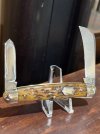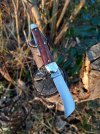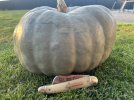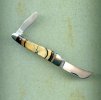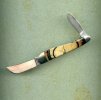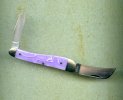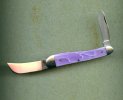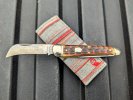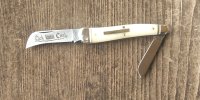-
The BladeForums.com 2024 Traditional Knife is available! Price is $250 ea (shipped within CONUS).
Order here: https://www.bladeforums.com/help/2024-traditional/
You are using an out of date browser. It may not display this or other websites correctly.
You should upgrade or use an alternative browser.
You should upgrade or use an alternative browser.
The " Roosters " are crowing for the " Farmers"
- Thread starter wlfryjr
- Start date
wlfryjr
Gold Member
- Joined
- Oct 20, 2011
- Messages
- 1,980
Will Power
Gold Member
- Joined
- Jan 18, 2007
- Messages
- 33,581
I can't answer you question about the techniques of sharpening sorry, I'm not very engrossed in sharpening- I just have a knack at it and that suffices for meThank you for sharing this, Will! Very, very interesting and useful.
Also it raises my long-favorite question about sharpening:
"If drawn along the stone with the BACK fisrt, as in stropping a razor, a firm edge cannot be obtained".
I ask - why? When I finish sharpening and transition to fine grit stone, I always draw blade with the back first. Never got a negative result, neither a negative feedback when sharpen someone's blade.
Of course, this advice is over 125 years old, basically Sheffield is no more than a nostalgia husk , none of the firms survive and steels have changed also techniques. However, I think it relevant and useful within the context of Pruner sharpening, a demanding skill. We should also note that Pruner knives, always an eccentric & intriguing pattern were by the early c20th largely displaced by quality secateurs. A tool brought about by improvements in viticulture . But who wants to EDC scissors in their pockets???
Last edited:
- Joined
- Oct 13, 2014
- Messages
- 261
- Joined
- Apr 12, 2009
- Messages
- 13,500
My 2 cents' worth...I can't answer you question about the techniques of sharpening sorry, I'm not very engrossed in sharpening- I just have a knack at it and that suffices for mePossibly
Obsessed with Edges may comment? All I can say is that when they compare it to razor stropping, it might be that razors of course demand the finest and keenest of edges, so when Turner suggest a FIRM EDGE CANNOT BE OBTAINED maybe they mean that a weak over fine edge will be produced ? That whilst initially very keen will soon lose retention ?
Of course, this advice is over 125 years old, basically Sheffield is no more than a nostalgia husk , none of the firms survive and steels have changed also techniques. However, I think it relevant and useful within the context of Pruner sharpening, a demanding skill. We should also note that Pruner knives, always an eccentric & intriguing pattern were by the early c20th largely displaced by quality secateurs. A tool brought about by improvements in viticulture . But who wants to EDC scissors in their pockets???
If the steel is ductile at low to moderate hardness like a low-alloy stainless steel at low-to-mid 50s HRC, I've not liked using edge trailing on stones or strops with compound, because the steel near the edge gets very drawn out and much too thin to be stable. I've arrived at this opinion in seeing this behavior on steels like 420HC or sometimes 440A and equivalents at mid-50s HRC. Also even on some low-hardness carbon steels like 1095, which is a waste of its potential at low hardness. I used to try thinning and polishing edges on steels like this, doing most of the polishing on strops with compound (chromium oxide, aluminum oxide, diamond, etc). It was pretty easy to make those edges shave and even tree-top hairs from my forearm. But they were always too fragile to hold up to much any other kind of cutting use. They'd roll too easily. Nowadays with steels like these, if I strop them at all, it's just on a bare strop like my leather belt used with no compound. And I prefer to finish these edges with edge-leading passes on the stone and then apply a very minimal microbevel in just 1-3 passes per side to give the finished edge a little more strength. Works especially well when applied to an edge finished to a medium grit finish (220-600) and then microbeveled on a medium or fine ceramic hone. Makes for a very aggressive slicing edge that stays more durable, on steels like this.
For shaving edges, I think edge-trailing on stones or strops might be better suited to steels that are somewhat harder (high 50s or higher) and therefore more stable at thinner geometry.
Last edited:
wlfryjr
Gold Member
- Joined
- Oct 20, 2011
- Messages
- 1,980
A Catt I picked up in Pigion Gorge this weekend
View attachment 2824257
That's a nice example of a rare Cattaraugus .
This one was definitely a sleeper of the latest run.




I got one, but not as nice of handles .
- Joined
- Oct 13, 2014
- Messages
- 261
wlfryjr
Gold Member
- Joined
- Oct 20, 2011
- Messages
- 1,980
Every time I see one of these with the patina obscuring the etch , I think it's my 2015 Lick Creek.
Hatchet_Jack
Basic Member
- Joined
- Sep 18, 2022
- Messages
- 3,013
wlfryjr
Gold Member
- Joined
- Oct 20, 2011
- Messages
- 1,980
I wrote this several weeks ago on AAPK.
It's been a whirlwind few days, negotiating all to do with the SFOs and then this Empire addition to the farmers jack collection. Thank you Pete for allowing me to put your Empire along side it's brothers and sisters, especially it's twin Shapleigh. Love the addition, and it's strange that the Shapleigh has a little used Pruning blade, whereas the Empire has a little used budding blade.
And much thanks Pete for adding the box that accompanies the knives almost perfectly.
The last picture is L-R Empire Shapleigh Empire Shapleigh
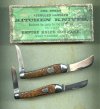
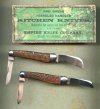
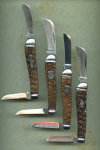
It's been a whirlwind few days, negotiating all to do with the SFOs and then this Empire addition to the farmers jack collection. Thank you Pete for allowing me to put your Empire along side it's brothers and sisters, especially it's twin Shapleigh. Love the addition, and it's strange that the Shapleigh has a little used Pruning blade, whereas the Empire has a little used budding blade.
And much thanks Pete for adding the box that accompanies the knives almost perfectly.
The last picture is L-R Empire Shapleigh Empire Shapleigh



wlfryjr
Gold Member
- Joined
- Oct 20, 2011
- Messages
- 1,980
I tried to get a jigged bone and stag , but I'm pleased with stag.Still carrying this one. Can't seem to get it out of the pocket.View attachment 2839543
Of course this one is a favorite.
echoscout
Gold Member
- Joined
- Oct 8, 2002
- Messages
- 7,711
Thank you Lyle. It's truly a favorite of mine alsoOf course this one is a favorite.







